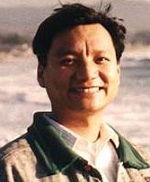| 题目:Typhoon-Related Seismic Ground Motions: Some Examples 时间:2016年10月20日下午 14:00-16:30 地点:玉泉校区信电楼117-119会议室 报告人:WU-CHENG CHI |  |
Abstract: Typhoons inflict large damage to societies, but are usually difficult to monitor in real- time without expensive instruments. Typhoons generate ocean waves, which generate pressure signals in the water column before being transmitted to the seafloor as seismic waves. The broadband (150 sec to 5 sec in period) seismic waves propagate a long distance and have been observed by ocean-bottom seismometers (OBSs) deployed on the seafloor and land. When a typhoon turns, the wave-wave interaction near the source region generates a new set of en echelon patterns. Similar features occur when a typhoon crosses a landmass and re-enters the ocean. The energy level ratio between the single-frequency and double-frequency microseisms also changes abruptly when the typhoon turns. These features can potentially help near real-time early warning with little cost to complement other conventional typhoon early warning methods. We can also use typhoon-generated ground motions on the seafloor to study oceanic crustal properties. It is noted that (1) OBS and differential pressure gauge (DPG) have shown different seafloor compliance (the elastic response of the oceanic crust due to the forcing of the infragravity waves in the water column) during the typhoon and the calm seas, and (2) experimental data show that the ground motions on the seafloor are mostly induced by in situ or nearby pressure fields, as shown by coherence function analyses. It is thus a challenge to design sensors/systems to separate the typhoon generated seismic waves from the local-wind generated ground motion. Integrated studies of typhoons using seismic, acoustic, and other data might help better understand some interrelated processes in atmosphere, hydrosphere, and lithosphere.
Biography: Dr. WU-CHENG CHI 戚�正 is a Associate Research Fellow at the Institute of Earth Sciences, Academia Sinica. He is Editor-in-Chief of the Marine Geophysical Research (Springer). He obtained his Ph.D. From the University of California, Berkeley, and worked as PostDoc at Woods Hole Oceanographic Institution and California Institute of Technology, USA